While the summer of 2020 has been anything but typical, that hasn’t stopped CalArts’ Community Arts Partnership (CAP) from expanding its work with elementary, middle, and high school students across Los Angeles County, as well as with its own community of instructors. In addition to the CAP Summer Arts program (CAPSA), the annual four-week interdisciplinary arts program for high school students held in July, CAP also hosted a new instructor training program this summer, which was generously supported by donor Walt Miller. The goal of the summer training was to provide CAP educators, most of whom are CalArts students or alumni, with the necessary tools to engage with the young participants of the programs.
For Dr. Veronica Alvarez, the Wallis Annenberg Director of the Community Arts Partnership, providing instructors with training in the art of teaching has been a priority since she began as director of CAP in July 2019. In fact, Alvarez’s research as a doctoral student confirmed that most artist-educators were provided with little or no training that promoted their professional growth as teachers.
“Teaching artists are very talented and knowledgeable about their artistic practice,” Alvarez said. “But often they ‘fall into’ the teaching profession without receiving any training as an educator. Once they find themselves in front of a group of 12th graders, they’ll often realize that what worked with fourth graders doesn’t necessarily work with older students. Yet, no one has trained them to work with different age groups—or with the diverse student populations that they often encounter in the CAP program.”
The CAP instructors who engaged in the training program took this message to heart and embraced the opportunity to learn more about how to engage a range of students in meaningful ways.
“The various training sessions that we had on different aspects of creating a brave, accepting, and inclusive space for the students were really eye opening,” said instructor Charles Burns (Music MFA 20), who participated in the training. “Teenagers specifically have a finely tuned sense of whether or not teachers respect them, so finding ways to help them feel heard, and giving them a say in how their experience goes, is especially helpful in building trust and rapport.”

Despite having to remain socially distant during the training because of COVID-19, the experience still helped to bring participants together in important ways. “We were able to community-build and discuss topics such as institutional racism and its effect on educational opportunities, trauma informed pedagogy, and the importance of culturally relevant pedagogy—topics that became even more relevant with what we were experiencing during this time,” said Alvarez.
CalArts established the Community Arts Partnership three decades ago, inspired by the belief that arts education is a powerful tool to foster academic and social equity, especially for children. CAP provides free, hands-on arts programming for children between the ages of 6-18 at community organizations and schools across Los Angeles County. This includes CAPSA, which is run each summer at Dorsey High School in the Crenshaw/Baldwin Village section of Los Angeles. CAP continues to grow as it works to fill the gap in arts education created as a result of continuing budget cuts in public schools. The program recently entered into a new partnership with the Saugus Union School District, located in the Santa Clarita Valley, to offer virtual programming at all 15 of their schools, which serve more than 10,000 students in the Santa Clarita Valley, during the 2020-21 school year.
“Many of our students in CAP programs have little to no resources to strengthen and support their own narratives and modes of expression,” said instructor Diego Robles (Film/Video MFA 15). “I say this, because I was one of these students, and continue to look for ways to breakthrough, live up to, and give back to these same student populations I am from.”
Continuing to invest in the ways that CAP connects with and educates students—regardless of their experiences and backgrounds—is critical to the mission of the program. “Having instructors that are prepared (and feel prepared) to teach students in one of the most diverse cities in the world is essential, for both the instructors and the participants,” Alvarez said.
The instructors have a similar feeling. Instructor Catherine Marino shared her thoughts on the program: “It is incredibly fulfilling to take part in a program that serves a community that I deeply value and the students who I so admire for their tenacious hunger to learn no matter the circumstance.”
—by Greg Houle
